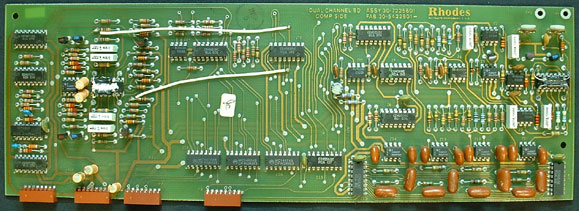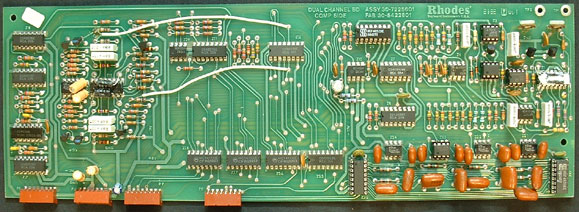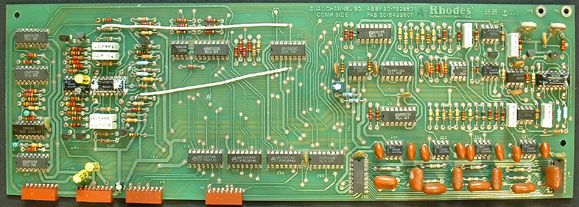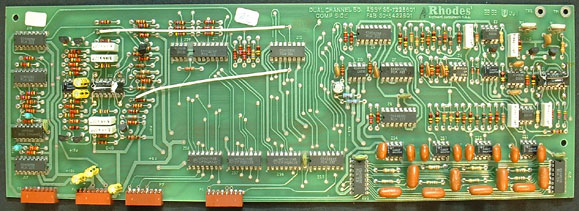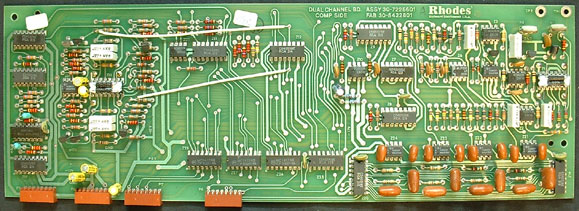Voice Board Revisions: The Changing Face of Chroma Dual Channel Voice Boards
By David Clarke [21030085++] <ac151@ncf.ca>Each Rhodes Chroma (and Rhodes Chroma Expander) contains 8, dual channel voice boards. It are these boards which allow the generation of the synthesizer's 16 voices.
Technical Service Bulletin FCN2-005 mentions the KRL and Tellabs Temperature Compensating resistors saying "Tel Labs resistors have a larger diameter and overhang the chip. This is readily apparent at a glance."
Recently, a mention was made on the Chroma mailing list of "...voice boards with the ARP logo." There have been things said about the Dual Channel Voice Boards, but there really haven't been too many pictures - and, at least to me, a picture is often better than words.
The following provides access to pictures of the voice boards, showing their changing face over their production period and points out a few key differences.
The Three Main Revisions
There is no single version of the dual-channel board that you'll find in all machines. In fact, in my experience there are at least 3 major board revisions that might be in any given Chroma, and even among those major revisions, there were different fabrication runs. Generally speaking, earlier boards will have more 'mods' on them, with later revisions having more of the 'mods' moved into the printed circuit board (PCB) design.
The earliest of the boards that I have seen still has the ARP logo on it, with several discrete components/wires added to the board. The last board revision (early 1984) had all all errors corrected, but still required two wire-straps (to make up for missing traces in the circuit board).
ARP
There is a version of the voice board which still bears the ARP name and logo, harkening back to the original design (see also additional pictures and information on the ARP voice boards):
Rhodes with Rear Trace-Cut
In the next revision of the board, it appears that all of the 'add-on' components from the "ARP" board were intended to be addressed in the circuit board layout itself. Unfortunately, it appears that an error was made during the layout, requiring a new trace-cut and strap be installed on the rear of the board. While it would have been expected that this error would have been caught (and addressed), it appears that several production runs of this exact same circuit board were made.
For more pictures of the boards with rear trace cut, see Voice Board Revisions: Rhodes (trace cut), or click on the picture to go directly to information on that board.
The first has no fabrication date (click images for more scans):
The second revision has a fabrication date of 21-82:
The third revision has a fabrication date of 22-82:
The fourth revision has a fabrication date of 25-82:
Rhodes with No Rear Trace-Cut
Still in 1982 it appears that the board was indeed re-laid out. This time, the error requiring the trace-cut and strap was fixed. However, this board still required two jumpers to be placed on the component side of the board (presumably because a re-layout effort to attempt to 'fit these in' would not have been cost effective).
For more pictures of these boards, see Voice Board Revisions: Rhodes (no trace cut), or click on the picture to go directly to information on that board.
First, 33-82:
Next, 42-82:
And 36-83:
Finally, there are boards with a fabriaction date of 21-84 (pictures not available). Based on the date-codes the ICs on 21-84, it appears that production was continuing well in to 1984.
"Complete"
While above I mentioned there were 3 main demarcations or revisions of the board, we have available pictures of a fourth.
For more information, see Voice Board Revisions: Clarke.
TEMPCO Resistors
FCN2-005 refers to the Tellabs resistors as having a larger diameter and overhang the chip. Without having something to compare them to, "larger" is hard to quantify. To help provide a bit more of a visual reference, the following two pictures provide an example of each (KRLP and Tellabs respectively).


Next: ARP



